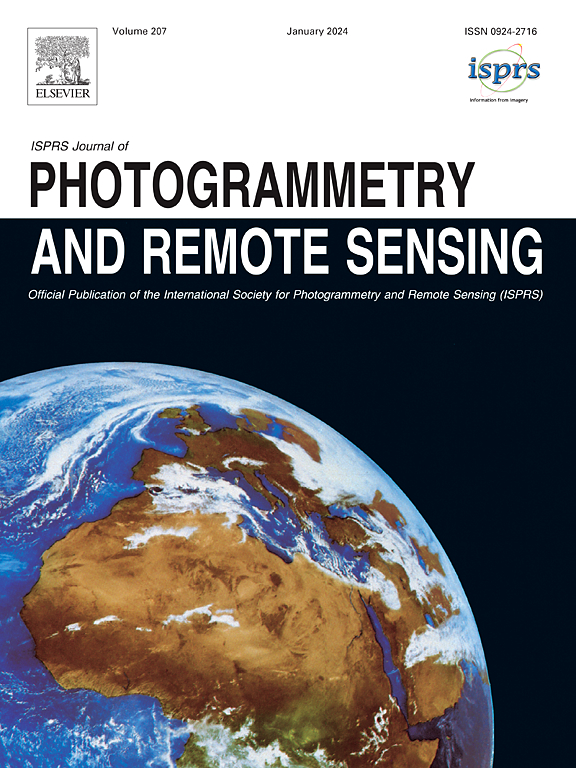A new methodology for establishing an SOC content prediction model that is spatiotemporally transferable at multidecadal and intercontinental scales
IF 12.2
1区 地球科学
Q1 GEOGRAPHY, PHYSICAL
ISPRS Journal of Photogrammetry and Remote Sensing
Pub Date : 2024-10-02
DOI:10.1016/j.isprsjprs.2024.09.038
引用次数: 0
Abstract
Quantifying and tracking the soil organic carbon (SOC) content is a key step toward long-term terrestrial ecosystem monitoring. Over the past decade, numerous models have been proposed and have achieved promising results for predicting SOC content. However, many of these studies are confined to specific temporal or spatial contexts, neglecting model transferability. Temporal transferability refers to a model’s ability to be applied across different periods, while spatial transferability relates to its applicability across diverse geographic locations for prediction. Therefore, developing a new methodology to establish a prediction model with high spatiotemporal transferability for SOC content is critically important. In this study, two large intercontinental study areas were selected, and measured topsoil (0–20 cm) sample data, 27,059 cloudless Landsat 5/8 images, digital elevation models, and climate data were acquired for 3 periods. Based on these data, monthly average climate data, monthly average data reflecting soil properties, and topography data were calculated as original input (OI) variables. We established an innovative multivariate deep learning model with high spatiotemporal transferability, combining the advantages of attention mechanism, graph neural network, and long short-term memory network model (A-GNN-LSTM). Additionally, the spatiotemporal transferability of A-GNN-LSTM and commonly used prediction models were compared. Finally, the abilities of the OI variables and the OI variables processed by feature engineering (FEI) for different SOC prediction models were explored. The results show that 1) the A-GNN-LSTM that used OI as the input variable was the optimal prediction model (RMSE = 4.86 g kg−1, R2 = 0.81, RPIQ = 2.46, and MAE = 3.78 g kg−1) with the highest spatiotemporal transferability. 2) Compared to the temporal transferability of the GNN, the A-GNN-LSTM demonstrates superior temporal transferability (ΔR2T = −0.10 vs. −0.07). Furthermore, compared to the spatial transferability of LSTM, the A-GNN-LSTM shows enhanced spatial transferability (ΔR2S = −0.16 vs. −0.09). These findings strongly suggest that the fusion of geospatial context and temporally dependent information, extracted through the integration of GNN and LSTM models, effectively enhances the spatiotemporal transferability of the models. 3) By introducing the attention mechanism, the weights of different input variables could be calculated, increasing the physical interpretability of the deep learning model. The largest weight was assigned to climate data (39.55 %), and the smallest weight was assigned to vegetation (19.96 %). 4) Among the commonly used prediction models, the deep learning model had higher prediction accuracy (RMSE = 6.64 g kg−1, R2 = 0.64, RPIQ = 1.78, and MAE = 4.78 g kg−1) and spatial transferability (ΔRMSES = 1.43 g kg−1, ΔR2S = −0.13, ΔRPIQS = −0.50, and ΔMAES = 1.09 g kg−1), and the linear model had the higher temporal transferability (ΔRMSET = 1.46 g kg−1, ΔR2T = −0.14, ΔRPIQT = −0.45, and ΔMAET = 1.29 g kg−1). 5) The deep learning models necessitated the OI, whereas the linear and traditional machine learning models necessitated FEI to achieve higher prediction accuracy. This study presents an important step forward in integrating multiple deep learning models to build a highly spatiotemporal transferability SOC prediction model.
建立可在多年代和洲际尺度上进行时空转换的 SOC 含量预测模型的新方法
量化和跟踪土壤有机碳(SOC)含量是实现长期陆地生态系统监测的关键一步。在过去十年中,人们提出了许多预测土壤有机碳含量的模型,并取得了可喜的成果。然而,这些研究大多局限于特定的时间或空间范围,忽视了模型的可移植性。时间上的可迁移性是指模型在不同时期的应用能力,而空间上的可迁移性则是指模型在不同地理位置的预测应用能力。因此,开发一种新方法来建立一个具有高度时空可转移性的 SOC 含量预测模型至关重要。本研究选取了两个大型洲际研究区,获取了三个时期的表土(0-20 厘米)测量样本数据、27059 幅无云 Landsat 5/8 图像、数字高程模型和气候数据。根据这些数据,计算出月均气候数据、反映土壤特性的月均数据和地形数据,作为原始输入变量(OI)。我们结合注意力机制、图神经网络和长短期记忆网络模型(A-GNN-LSTM)的优势,建立了一个创新的多变量深度学习模型,该模型具有很高的时空转移性。此外,还比较了 A-GNN-LSTM 和常用预测模型的时空转移性。最后,探讨了 OI 变量和经过特征工程(FEI)处理的 OI 变量在不同 SOC 预测模型中的能力。结果表明:1)以 OI 为输入变量的 A-GNN-LSTM 是最优预测模型(RMSE = 4.86 g kg-1,R2 = 0.81,RPIQ = 2.46,MAE = 3.78 g kg-1),具有最高的时空转移性。2) 与 GNN 的时空转移性相比,A-GNN-LSTM 的时空转移性更好(ΔR2T = -0.10 vs. -0.07)。此外,与 LSTM 的空间转移性相比,A-GNN-LSTM 显示出更强的空间转移性(ΔR2S = -0.16 vs. -0.09)。这些发现有力地表明,通过整合 GNN 和 LSTM 模型提取的地理空间上下文和时间相关信息的融合,有效地增强了模型的时空转移性。3) 通过引入注意力机制,可以计算不同输入变量的权重,提高深度学习模型的物理可解释性。其中,气候数据的权重最大(39.55%),植被数据的权重最小(19.96%)。4) 在常用预测模型中,深度学习模型具有更高的预测精度(RMSE = 6.64 g kg-1,R2 = 0.64,RPIQ = 1.78,MAE = 4.78 g kg-1)和空间转移性(ΔRMSES = 1.43 g kg-1,ΔR2S = -0.13,ΔRPIQS = -0.50,ΔMAES = 1.09 g kg-1),线性模型具有更高的时间转移性(ΔRMSET = 1.46 g kg-1,ΔR2T = -0.14,ΔRPIQT = -0.45,ΔMAET = 1.29 g kg-1)。5) 深度学习模型必须使用 OI,而线性和传统机器学习模型必须使用 FEI 才能达到更高的预测精度。本研究在整合多种深度学习模型以建立高时空转移性 SOC 预测模型方面迈出了重要一步。
本文章由计算机程序翻译,如有差异,请以英文原文为准。
求助全文
约1分钟内获得全文
求助全文
来源期刊

ISPRS Journal of Photogrammetry and Remote Sensing
工程技术-成像科学与照相技术
CiteScore
21.00
自引率
6.30%
发文量
273
审稿时长
40 days
期刊介绍:
The ISPRS Journal of Photogrammetry and Remote Sensing (P&RS) serves as the official journal of the International Society for Photogrammetry and Remote Sensing (ISPRS). It acts as a platform for scientists and professionals worldwide who are involved in various disciplines that utilize photogrammetry, remote sensing, spatial information systems, computer vision, and related fields. The journal aims to facilitate communication and dissemination of advancements in these disciplines, while also acting as a comprehensive source of reference and archive.
P&RS endeavors to publish high-quality, peer-reviewed research papers that are preferably original and have not been published before. These papers can cover scientific/research, technological development, or application/practical aspects. Additionally, the journal welcomes papers that are based on presentations from ISPRS meetings, as long as they are considered significant contributions to the aforementioned fields.
In particular, P&RS encourages the submission of papers that are of broad scientific interest, showcase innovative applications (especially in emerging fields), have an interdisciplinary focus, discuss topics that have received limited attention in P&RS or related journals, or explore new directions in scientific or professional realms. It is preferred that theoretical papers include practical applications, while papers focusing on systems and applications should include a theoretical background.
 求助内容:
求助内容: 应助结果提醒方式:
应助结果提醒方式:


